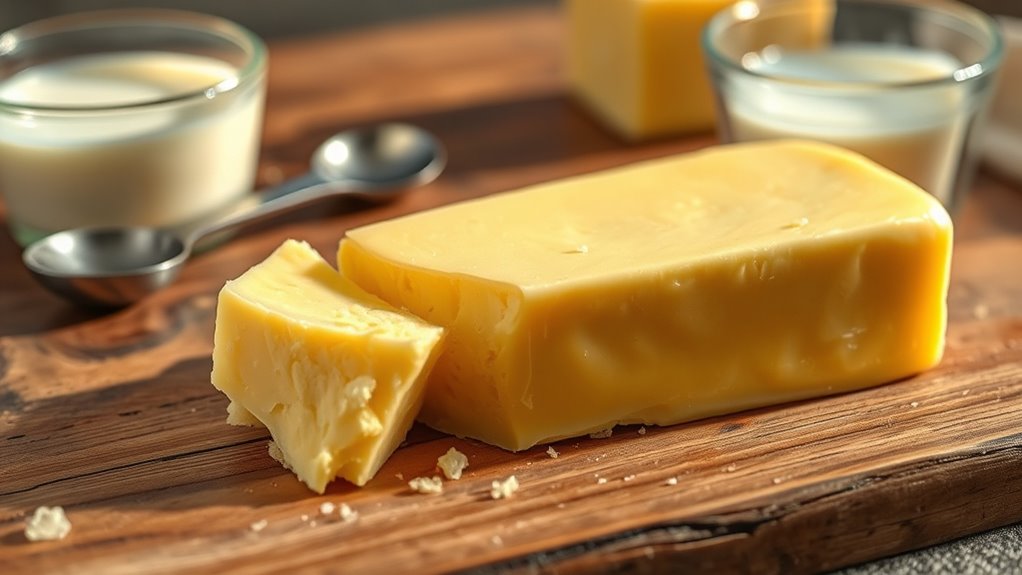Butter typically contains less than 1 gram of lactose per tablespoon, making it safe for many people with lactose intolerance when eaten in moderation. Since processing and fermentation reduce lactose levels, choosing carefully processed or cultured butters can lower your risk of discomfort. However, your tolerance varies, so monitor how small portions affect you. If you want to learn more about safe amounts and alternatives, there’s useful information that can help you manage your diet effectively.
Key Takeaways
- Butter typically contains less than 1 gram of lactose per tablespoon, making it generally safe for most lactose-intolerant individuals.
- Processing and fermentation methods further reduce lactose levels in butter, especially in commercially produced varieties.
- Tolerance varies; many can consume 1–2 tablespoons of butter without symptoms, but individual sensitivities differ.
- Always check labels for “lactose-free” or “made without milk” to ensure minimal lactose content.
- Monitoring personal reactions and portion sizes helps determine safe butter consumption levels for lactose intolerance.
Understanding Lactose in Dairy Products
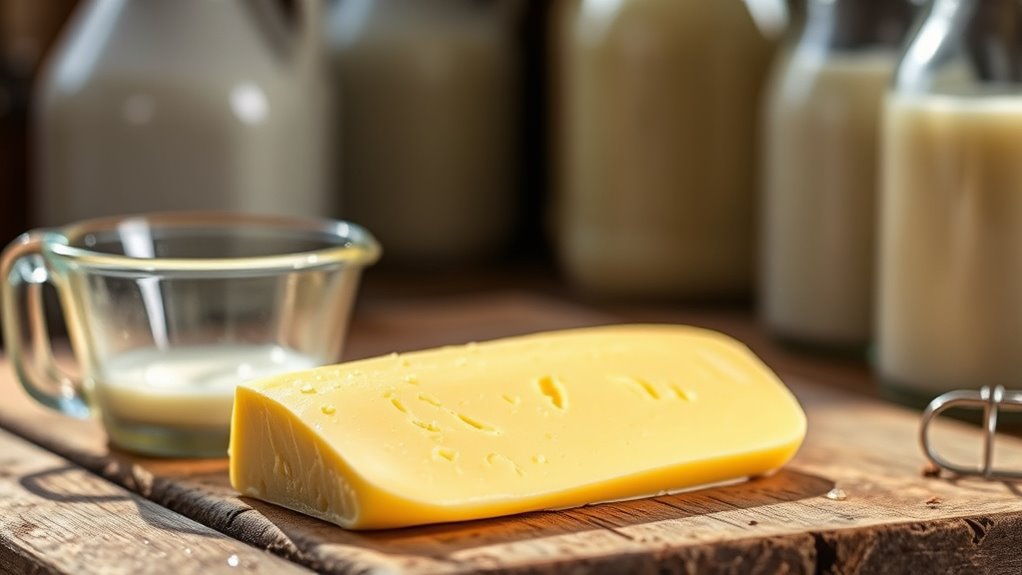
Lactose is a natural sugar found in milk and most dairy products, and understanding its presence is key if you’re concerned about lactose intolerance. During fermentation effects, bacteria break down lactose into simpler sugars, reducing its amount in products like yogurt and cheese. However, butter contains minimal lactose because it’s primarily made from cream with most of the lactose removed during butter storage. Proper storage of butter in cool, airtight conditions helps preserve its quality and prevents spoilage, but it doesn’t affect lactose content considerably. Recognizing how fermentation effects decrease lactose levels can help you choose dairy products that are easier to digest. Additionally, the processing methods used in butter production further reduce its lactose content, making it a suitable option for many lactose-intolerant individuals. While butter’s lactose is very low, being aware of storage can prevent confusion about its lactose content and ensure you’re making safe choices.
How Much Lactose Is in Butter?
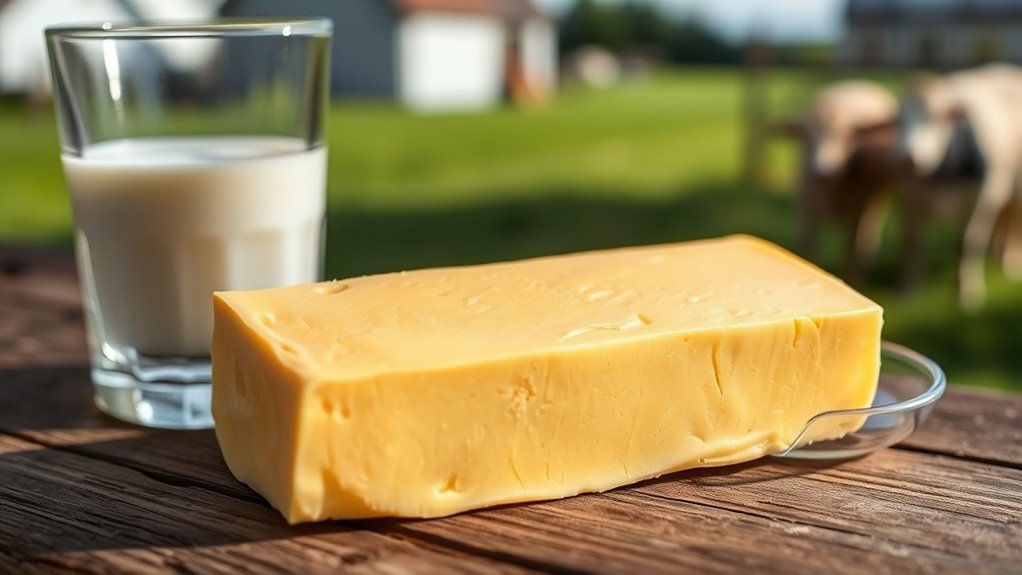
Have you ever wondered how much lactose is actually in butter? Typically, butter contains less than 1 gram of lactose per tablespoon, making it a low-lactose dairy product. Its flavor profiles range from rich and creamy to nutty and tangy, depending on the butter’s production process and cultural butter usage. In some cultures, butter is a staple ingredient, used in cooking and baking, while others prefer clarified butter or ghee, which has even less lactose. Because most of the lactose is removed during churning, butter generally poses minimal risk for those with lactose intolerance. Additionally, nutrient retention is high in butter compared to other dairy products, which is beneficial for nutrition. However, it’s important to check labels if you’re highly sensitive, as small traces can still be present. Overall, butter’s low lactose content makes it a safe choice for many.
Variations in Lactose Content Among Different Types of Butter

Different types of butter can vary markedly in their lactose content, influenced by processing methods and cultural practices. Cream variations, such as sweet cream or cultured cream, impact the final lactose levels, with cultured butters often containing slightly more due to fermentation. Additionally, butter aging plays a role; older, traditionally churned butters may have reduced lactose because some lactose ferments during storage. Commercial butters typically undergo processing that minimizes lactose, resulting in lower levels. Artisanal or raw butters might retain more lactose, depending on their production process. Understanding these factors helps you estimate lactose content more accurately. If you’re lactose intolerant, choosing butters made from cream with specific variations and considering aging processes can help you enjoy butter without discomfort. Processing methods also influence lactose levels by determining the extent of fermentation and removal during production.
Determining Safe Consumption Levels for Lactose Intolerance
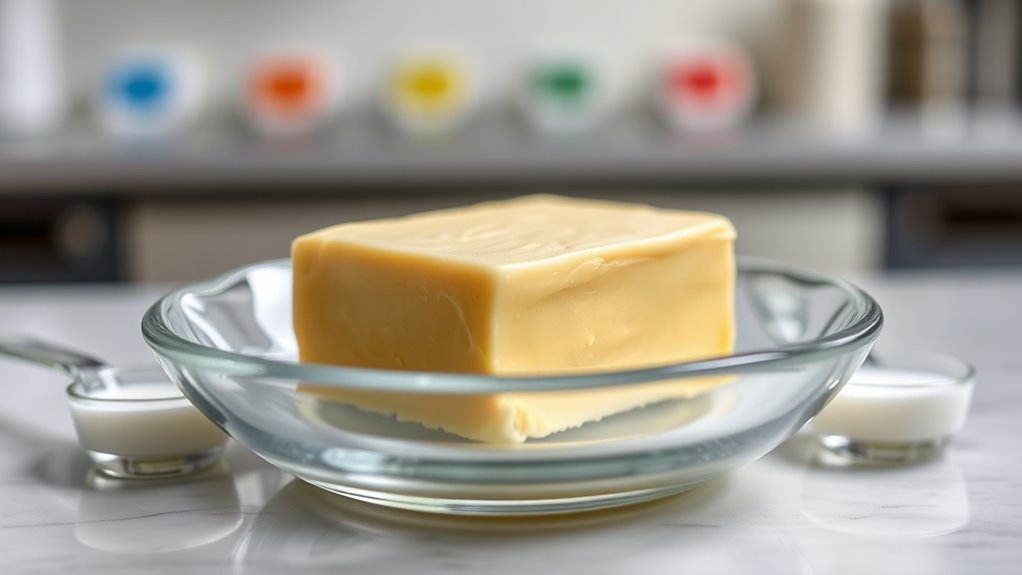
Understanding your lactose tolerance threshold helps you decide how much butter you can enjoy safely. Knowing the recommended portion sizes guarantees you avoid discomfort while still including butter in your diet. Let’s explore how to determine what works best for your individual needs. Incorporating personalized user profiles can help track your response to different amounts of butter and fine-tune your intake.
Tolerance Thresholds Explained
Determining safe lactose consumption levels hinges on understanding individual tolerance thresholds. Your ability to digest lactose depends on how well your body produces the dairy enzyme, lactase. Some people can handle small amounts without symptoms, while others react to even tiny doses. Factors like age, genetics, and gut health influence your lactose digestion capacity. To help clarify, here’s a simple table:
| Tolerance Level | Description | Symptoms |
|---|---|---|
| Low | Very sensitive, reacts to small doses | Bloating, diarrhea, stomach pain |
| Moderate | Handles some dairy, symptoms with larger amounts | Mild discomfort after eating dairy |
| High | Tolerant, can consume more without issues | Rare symptoms even with larger servings |
Knowing your threshold helps you manage your dairy intake safely. Lactose digestion varies among individuals, making personalized awareness essential.
Portion Size Recommendations
Knowing your individual lactose tolerance level helps you identify safe portion sizes to enjoy dairy without discomfort. Since butter contains low lactose levels, understanding typical amounts is key. For example, a standard butter package from dairy farming usually offers about 14 grams per tablespoon, which is generally safe for most lactose-intolerant people if eaten in moderation. To prevent symptoms, limit your intake to 1-2 tablespoons per serving, depending on your tolerance threshold. Keep in mind that larger portions increase lactose intake, so be mindful when using butter in recipes or spreads. Reading butter packaging labels can help you track servings easily. By adjusting portion sizes based on your sensitivity, you can enjoy butter safely without risking lactose-related discomfort.
Reading Labels and Identifying Lactose-Free Butter Options
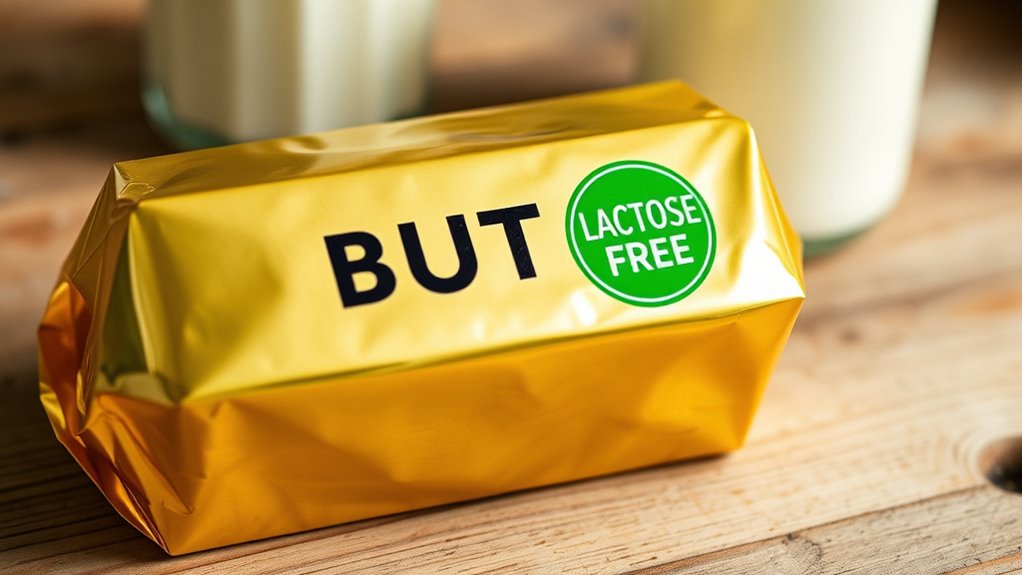
When you’re checking labels for lactose-free butter options, start by reading the ingredient list carefully. Look for phrases like “lactose-free” or “made without milk.” Many products labeled as lactose-free are safe for those with lactose intolerance, but always verify. Use this quick reference to guide your label reading:
| Label Term | What to Look For | Notes |
|---|---|---|
| Lactose-Free | No lactose present | Confirm with manufacturer |
| Made Without Milk | No milk ingredients | Check for hidden dairy |
| Dairy-Free | No dairy ingredients | Usually safe for lactose intolerance |
| Contains Milk | Contains lactose | Avoid these options |
Sticking to clearly labeled lactose-free options helps you avoid discomfort and makes shopping easier. Always double-check product labels to ensure they meet your dietary needs.
Tips for Incorporating Butter Into a Lactose-Restricted Diet

To successfully include butter in a lactose-restricted diet, focus on choosing the right types and using them mindfully. Proper butter storage is key; keep butter refrigerated to maintain freshness and prevent spoilage, ensuring you use it within recommended timeframes. When cooking or spreading, remember that butter’s flavor variations can enhance meals without adding extra lactose. Try different types, such as clarified butter or grass-fed options, which may have lower lactose levels. Use small amounts to gauge your tolerance and avoid overconsumption. Incorporate butter gradually into your meals, paying attention to how your body responds. By selecting quality butter and managing portions, you can enjoy its richness while staying within your lactose limits. Additionally, understanding the lactose content of butter can help you make more informed dietary choices.
Alternatives to Butter for Lactose-Intolerant Individuals
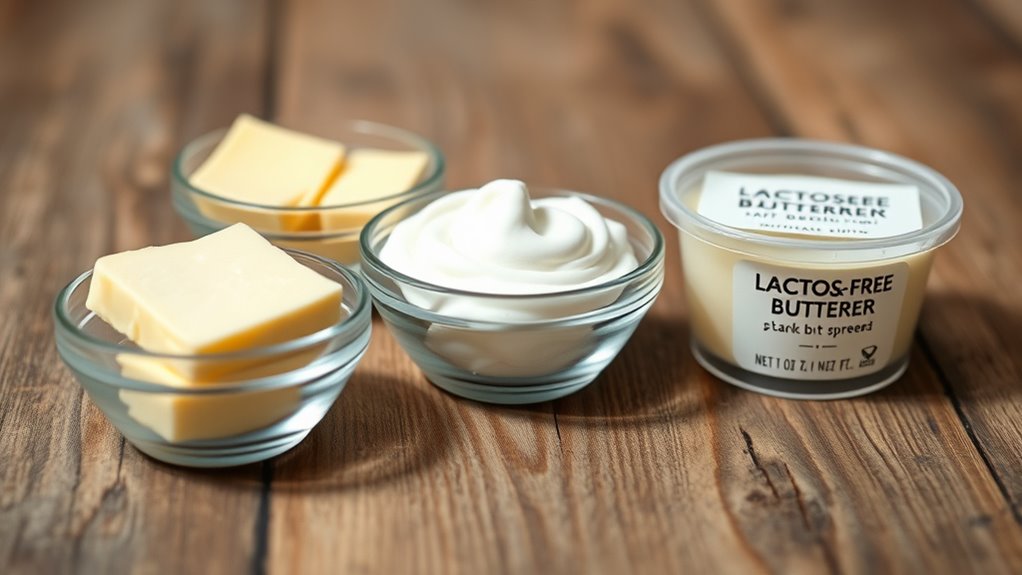
If you’re looking to avoid butter, there are plenty of plant-based substitutes that work well. Dairy-free spreads and margarine options can also provide similar textures and flavors. You might even try making your own alternatives at home for a customizable and fresh approach. For those interested in sustainable energy sources, some individuals use bike generators to produce small amounts of renewable energy, which can be a fun and eco-friendly project.
Plant-Based Butter Substitutes
For those who are lactose intolerant, plant-based butter substitutes offer a tasty and dairy-free alternative to traditional butter. These options are made from plant-based fats like coconut oil, olive oil, or avocado, providing healthy fats and rich flavors. Vegan spreads are popular choices, often crafted from oils, nuts, or legumes, and they mimic butter’s texture and taste. Many store-bought options are fortified with vitamins and minerals, making them nutritious substitutes. You can use these spreads for cooking, baking, or spreading on bread without worrying about lactose content. Since they contain no dairy, plant-based butter substitutes are suitable for vegan lifestyles and those avoiding lactose. They’re a versatile, safe, and tasty way to enjoy butter-like qualities without the dairy. Additionally, plant-based fats are a key component of these substitutes, offering a variety of health benefits and flavor options.
Dairy-Free Spreads Options
When seeking dairy-free spreads as alternatives to traditional butter, you’ll find a variety of options designed to suit lactose-intolerant lifestyles. These plant-based spreads are versatile, offering flavors and textures similar to butter without the lactose. You can choose from options like coconut oil, avocado-based spreads, or nut butters, depending on your taste preferences. Here’s a quick overview:
| Spread Type | Main Ingredients | Best Uses |
|---|---|---|
| Coconut-based | Coconut oil, emulsifiers | Baking, toast |
| Nut butters | Almond, cashew, peanut | Sandwiches, dips |
| Avocado spreads | Mashed avocado, lemon | Toast, salads |
Explore these dairy-free options to enjoy your favorite dishes without worry.
Homemade Alternatives Tips
Making homemade dairy-free butter alternatives is a simple way to enjoy familiar textures and flavors without lactose. You can customize your spread with natural butter flavorings like nutritional yeast, roasted garlic, or smoked paprika to mimic traditional butter’s richness. Using artisanal techniques, such as blending coconut oil with a touch of vegan margarine or olive oil, creates a creamy, spreadable consistency. Incorporate a pinch of salt or a splash of lemon juice to enhance flavor depth. For added authenticity, try infusing your homemade butter with herbs or spices. These methods allow you to craft personalized, flavorful alternatives that suit your taste while avoiding lactose. Additionally, understanding the organic techniques for seed production can inspire you to create healthier, more sustainable ingredients for your homemade spreads. With a little experimentation, you’ll develop delicious, lactose-free spreads that satisfy your cravings and elevate your dishes.
Monitoring Your Body’s Response to Butter Consumption

Keeping track of how your body reacts to butter can help you identify any sensitivities or intolerances. Pay close attention to symptoms like bloating, stomach pain, or changes in digestion after consumption. Monitoring these responses allows you to determine whether the butter’s nutritional benefits outweigh any discomfort. Since butter offers rich flavor profiles, it can enhance your meals without compromising your health if tolerated well. Keep a journal of your intake and symptoms to spot patterns over time. If you notice adverse effects, consider testing different butter types or limiting your intake. This proactive approach helps you enjoy the flavor and nutritional benefits of butter safely while avoiding unwanted digestive issues. Listening to your body ensures a balanced, enjoyable diet tailored to your needs.
Frequently Asked Questions
Can Lactose-Free Butter Be Completely Free of All Dairy Proteins?
You wonder if lactose-free butter is entirely free of dairy proteins. While lactose-free certification mainly addresses lactose removal, it doesn’t guarantee complete dairy protein elimination. Dairy protein removal depends on manufacturing processes, and some small amounts might remain. Always check labels and look for products specifically labeled as dairy-free or with verified dairy protein removal to ensure you’re avoiding all dairy proteins, especially if you have a severe allergy.
How Does Aging or Processing Affect Butter’S Lactose Content?
Like fine wine, butter’s aging and processing can influence its lactose levels. Aging effects typically allow some lactose to break down, reducing its content, while processing impacts, such as churning and filtering, can further lower lactose. These changes may make aged or specially processed butter safer for lactose-intolerant individuals. You should still check labels, but understanding these factors helps you choose butter that’s gentler on your system.
Are There Any Health Risks Associated With Consuming Small Amounts of Lactose?
You might wonder if small amounts of lactose pose health risks. If you have lactose digestion issues, consuming minimal lactose usually isn’t harmful, but it can cause discomfort if you’re highly sensitive. For those with a dairy allergy, even tiny amounts can trigger serious reactions. It’s best to be cautious, read labels carefully, and consult with your healthcare provider to understand your tolerance level and avoid potential health issues.
What Are the Best Storage Practices to Prevent Lactose Fermentation in Butter?
Did you know that improper storage can cause butter to develop off-flavors and spoilage? To prevent lactose fermentation, you should always use proper storage methods. Keep butter in an airtight container in the refrigerator at 35-40°F, and avoid contamination by using clean utensils. Proper storage minimizes exposure to moisture and bacteria, ensuring your butter stays fresh longer and resists fermentation.
Can Lactose Intolerance Symptoms Worsen Over Time With Regular Butter Consumption?
You might wonder if your lactose intolerance symptoms can worsen over time with regular butter intake. While butter has low lactose, cumulative effects of small amounts can cause symptom progression in sensitive individuals. If you notice worsening symptoms, it’s wise to monitor your intake and consult a healthcare professional. Over time, even tiny exposures could lead to more noticeable symptoms, so staying aware helps manage your condition effectively.
Conclusion
Understanding lactose in butter helps you make smarter choices, but remember, even small amounts can be a wolf in sheep’s clothing for your digestion. By reading labels and exploring lactose-free options, you’re steering clear of trouble and keeping your gut happy. Think of it as maneuvering a maze—your awareness is the map that leads you safely through. Trust your body’s signals, and enjoy butter in a way that’s kind to your lactose intolerance.
